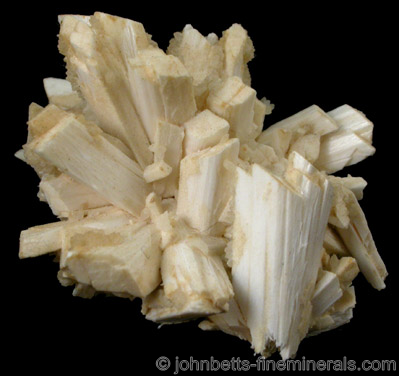The Mineral laumontite

Laumontite is a member of the zeolite group, and occurs in many of the zeolite deposits. It is not a stable mineral, losing water in its structure upon exposure to air. This causes Laumontite to be white and powdery, and will cause specimens to crumble when touched. Large crystals can be preserved by coating it with a plastic waterproof sealant. Laumontite was named after Gillet de Laumont (1747-1834), a French mineralogist and hunter credited with discovering this mineral in Brittany, France in 1785.
Chemical Formula
CaAl2Si4O12 · 4(H2O)
Color
Colorless to white. Also light yellow, off-white, and tan.
Crystal System
Monoclinic
Properties
Streak
Colorless |
Hardness
3.5 - 4 |
Transparency
Transparent to opaque |
Specific Gravity
2.2 - 2.3 |
Luster
Vitreous, pearly, dull |
Cleavage
1,2 |
Fracture
Uneven |
Tenacity
Brittle |
Other ID Marks
Efflorescent. A white powder will form on crystal surfaces of Laumontite from dehydration.
|
Varieties
-
Describing partially dehydrated opaque Laumontite, with a crumbly, powdery white habit.
Noteworthy Localities
Though Laumontite is not uncommon and is found in many localities, it is often just an accessory mineral and only occasionally in good crystals. Furthermore, since it is an unstable mineral, even specimens from good localities are not commonly encountered unless they are sealed for preservation. Only a few select localities are mentioned here.
The Indian zeolite localities in the state of Maharashtra are producers of fine Laumontite, especially at Mumbai (Bombay), Nasik, and Pune (Poona). Mumbai is especially noteworthy for its beautiful epimorphs of Prehnite after Laumontite, where the Prehnite grew around long prismatic Laumontite crystals and then the Laumontite dissolved.
In Europe, large, well-formed Laumontite crystal clusters were found in La Cabrera, Madrid, Spain. Small crystal groups come from Baveno and Beura, Piedmont, Italy; and small acicular clusters from Osilo, Sardinia, Italy.
In the U.S., very large, well-formed prismatic Laumontite crystals were found in the Pine Creek Mine, Bishop, Inyo Co., California. Small crystal groups come from the Bear Creek Quarry, Drain, Douglas Co., Oregon. Fine Laumontite crystals, often in association with other zeolites, come from Passaic Co., New Jersey, at the Upper New Street Quarry in Paterson, and nearby at Prospect Park.
Distingushing Similar Minerals
The crystal habit and efflorescent nature of Laumontite can distinguish it from virtually all minerals.